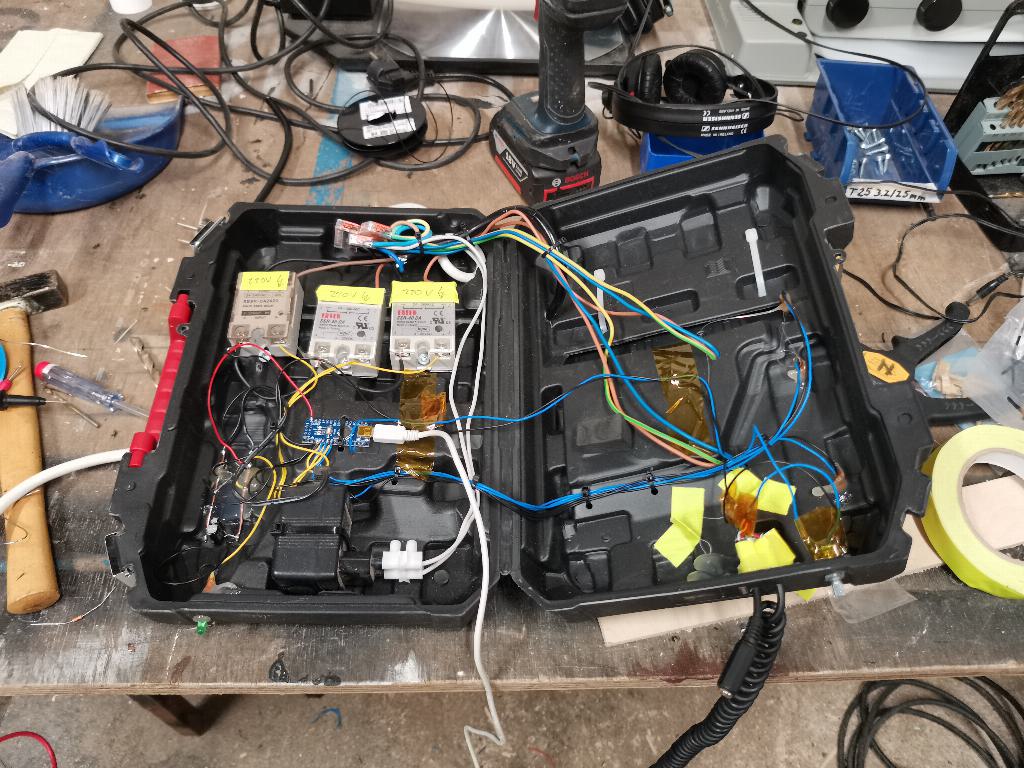Strahlomat

Kinetic light installation
In Winter 2023/24, Kati and I had the chance to work at Haihatus, an art center in rural Finland. During our stay, we created an installation for KITA, the house of kinetic arts.

KITA is closed for visitors in winter, as the building has no heating. Therefore, our idea was to bring the house to life so that there would be something interesting to see from the outside. We created the “Strahlomat”, a kinetic light installation where motorized mechanisms move spotlights slowly back and forth on a 2-meter long rail. The rails were mounted at windows inside KITA. To create interesting light effects, we hung color gels, transparent foils with patterns, refracting lenses, prisms, and mirrors at various distances in front of the moving lights. The purpose of this setup was to cast moving shadows and shifting projections through KITA’s windows onto the white snow outside the building.




Together with Tuomo Vuoteenoma, the artistic director of KITA, we also installed a light chain along the colorful geometric shapes on the building's exterior. Furthermore, we illuminated the entire house with color-changing spotlights from the outside and placed colorful lamps behind a few windows on the inside.

To turn the different light effects on and off in interesting patterns, I built the “Power Box 2000”. Housed in an old plastic tool case and with an Arduino Nano microcontroller at its core, this control box generated chip-tune-style sounds and music, while also switching the lights and the Strahlomat contraptions on and off for different durations.



The program on the Arduino inside the Power Box featured a variety of tone creation algorithms. Some of them played melodies, others sounded rather percussive. From time to time the box would produce morse code and sometimes just plain noise. Each of those algorithms was based on random values, so the exact same sounds would never repeat and an overall logic switched between the different algorithms randomly. Since the microcontroller did both - creating the sounds and also switching the lights - the light show was always synchronized with the emitted sound. On New Year's Eve 2023, Strahlomat was inaugurated, KITA beeped and blinked and we celebrated together with the people of Joutsa, with a campfire and a cup of glögi.
Since this was the first time that KITA featured such an installation during winter, the idea was also to test how the mechanisms could handle the harsh conditions long-term. Even if the installation was inside, the thermometer hit -30°C. Somewhat expectedly we had challenges with both the mechanical and electronic parts and having Strahlomat running continuously was not always possible. However, these experiences can be useful for other winter installations.
Back at Haihatus, I found a beautiful old rotary phone, which inspired the creation of a spin-off project, the “Algofon”. Since I already wrote all those different sound creation algorithms for the Power Box, I recycled ten of the nicest code snippets and put them onto another microcontroller, inside the phone. Instead of playing the sounds at random, the rotary dial controls which algorithm is chosen. Now, one can pick up the handset, which turns on the now battery powered phone, listen to a 440Hz beep and then dial in the number of one of those sound creation algorithms in order to enjoy the generative audio.

Pump up the volume if you want to hear the generative sounds!
We had a really good time at Haihatus, and at the end, there was even a report in the local newspaper about our project! The article also mentions “Moccamaster 3000”, a high-speed coffee drinking game that we also built during our stay.

Thanks
Special thanks to Haihatus and all the nice people there for the inspiring conversations and the really good time, Tuomo Vuoteenoma for the fruitful collaboration, and Taike, the Arts Promotion Centre Finland, for funding this project.
Additional resources
- All Strahlomat project photos (diary album)
- All Algofon project photos (diary album)
- All Moccamaster 3000 photos (diary album)
- All Haihatus and KITA photos (diary album)
- Algofon code